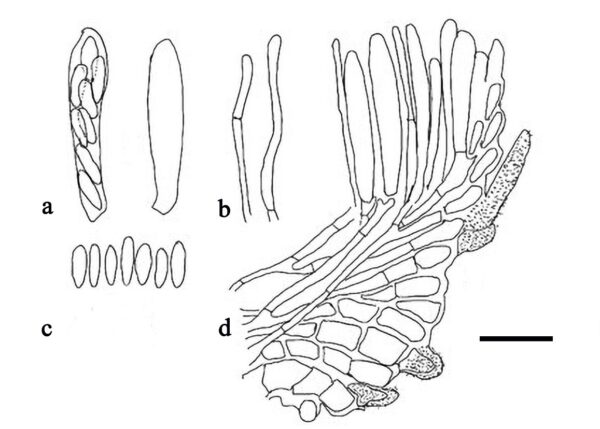Fungalpedia – Note 366, Hyphopeziza
Hyphopeziza J.G. Han, Hosoya & H.D. Shin
Citation when using this data: Tibpromma et al. 2024 (in prep.) – Fungalpedia, Ascomycota.
Index Fungorum, Facesoffungi, MycoBank, GenBank, Fig. 1
Classification: Hyaloscyphaceae, Helotiales, Leotiomycetidae, Leotiomycetes, Pezizomycotina, Ascomycota, Fungi
Hyphopeziza (Hyaloscyphaceae) was established by Han et al. (2014) with containing only the type species Hyphopeziza pygmaea. Previous studies have identified Hyphopeziza pygmaea as Unguicularia pygmaea and Hyaloscypha subtilis var. Drupacea, but Han et al. (2014) re-identified them as the type species of the new genus Hyphopeziza based on morphological characteristics comparison coupled with LSU-ITS multi-gene phylogenetic analysis. Hyphopeziza was characterized by having superficial apothecia, gregarious and broadly sessile; flat to slightly convex, Initially cup-shaped, the receptacle becomes discoid, externally covered with white to grayish hairs; ectal excipulum is composed of thin-walled, globose to isodiametric cells that range in color from hyaline to pale brown, thicken toward the base; hairs are cylindric-conical to lageniform, entirely coarsely warty, hyaline, aseptate, occasionally 1-septate near the base, hairs have a glassy wall that persists even after potassium hydroxide (KOH) pretreatment; paraphyses are cylindric and hyaline, with a clavate or lanceolate apex, mostly aseptate, occasionally 1-septate near the base, the apical parts of paraphyses turn coarsely warty and glassy, resembling hairs; asci arise from croziers and are clavate to cylindric-clavate, hyaline, with a conical apex, and the apical pore turns blue in Melzer’s reagent; ascospores are bi-seriate, ranging from elliptic-clavate to cuneiform or ellipsoid, hyaline, aseptate, aguttulate, and smooth. (Han et al. 2014, Quijada et al. 2022). To date, Hyphopeziza species have been found from unknown woods, twigs and leaves, or Alnus viridis, leaves of Quercus sp., bamboo in Korea, Switzerland and Japan (Han et al. 2014, Quijada et al. 2022).
Type species: Hyphopeziza pygmaea (Mouton) J.G. Han, Hosoya, H.D. Shin
Other accepted species: This genus is monotypic.
Figure 1 – Morphology of Hyphopeziza. a Asci. b Paraphyses. c Ascospores. d Peridium. Scale bars = 10 μm. Redrawn from Quijada et al. (2022).
References
Entry by
Yang EF, Department of Biology, Faculty of Science, Chiang Mai University, Chiang Mai 50200, Thailand; Center for Yunnan Plateau Biological Resources Protection and Utilization, College of Biological Resource and Food Engineering, Qujing Normal University, Qujing, Yunnan 655011, China.
(Edited by Saowaluck Tibpromma, Samaneh Chaharmiri-Dokhaharani, & Achala R. Rathnayaka)
Published online 14 November 2024
